Organizational Behaviour Report: Waitrose Case Study Analysis
VerifiedAdded on 2021/02/19
|19
|5360
|27
Report
AI Summary
This report provides an in-depth analysis of organizational behaviour within Waitrose, a major British supermarket chain. It explores the impact of organizational culture, power dynamics, and political influences on individual and team behaviour and performance. The report examines various aspects of organizational culture including power, role, person, and task cultures, and how Waitrose's adoption of a role culture affects its employees. Furthermore, it delves into the content and process theories of motivation, such as Maslow's Hierarchy of Needs, Herzberg's Two-Factor Theory, Equity Theory, and Expectancy Theory, and how these theories can be applied to achieve organizational goals. The report also differentiates between effective and ineffective teams and the factors that contribute to team success, including how Waitrose can use legitimate power to influence employee performance and behaviour. This report will provide students with a comprehensive overview of organizational behaviour concepts and philosophies, offering insights into how these principles apply within a real-world business context, with a focus on Waitrose's strategies and practices.
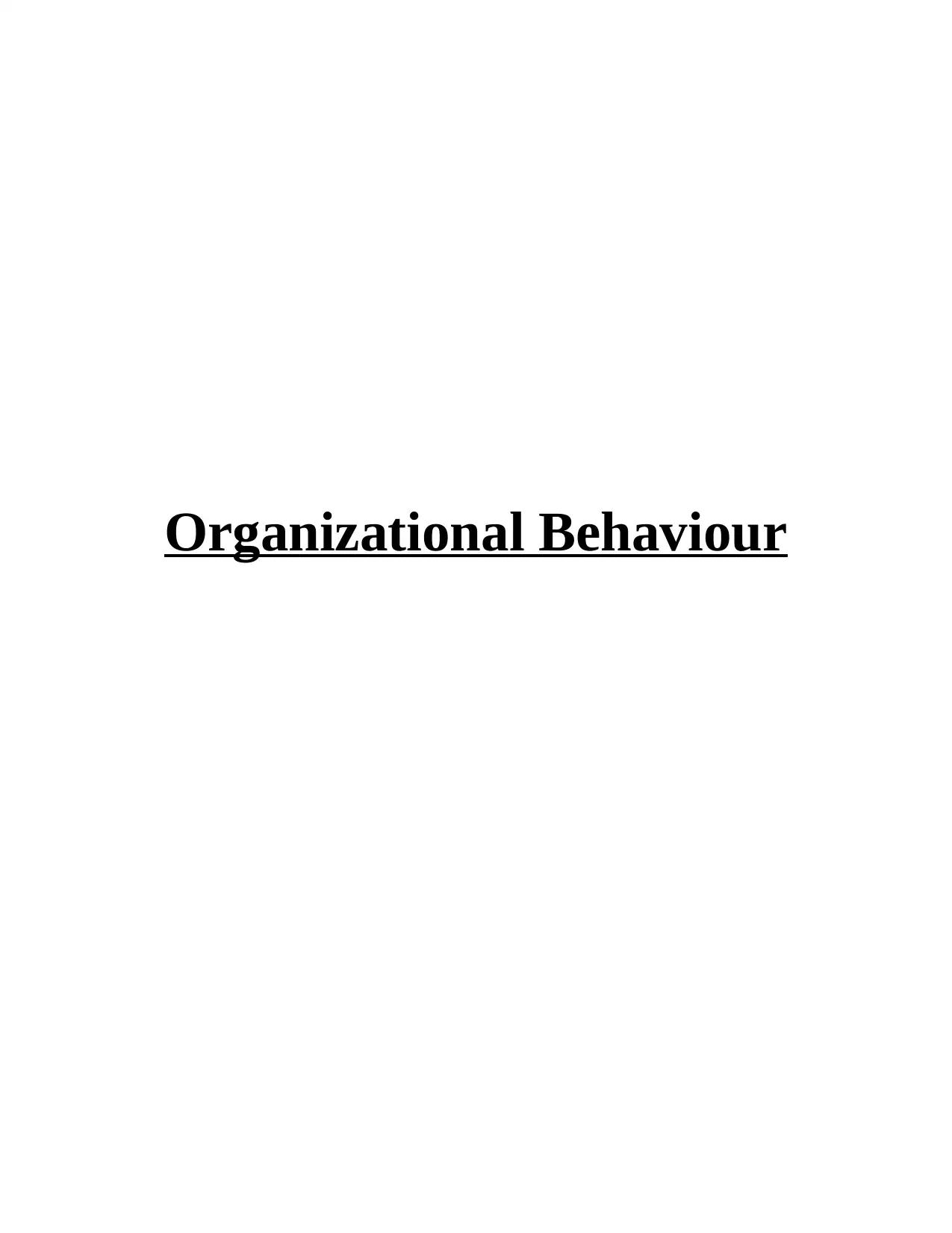
Organizational Behaviour
Paraphrase This Document
Need a fresh take? Get an instant paraphrase of this document with our AI Paraphraser
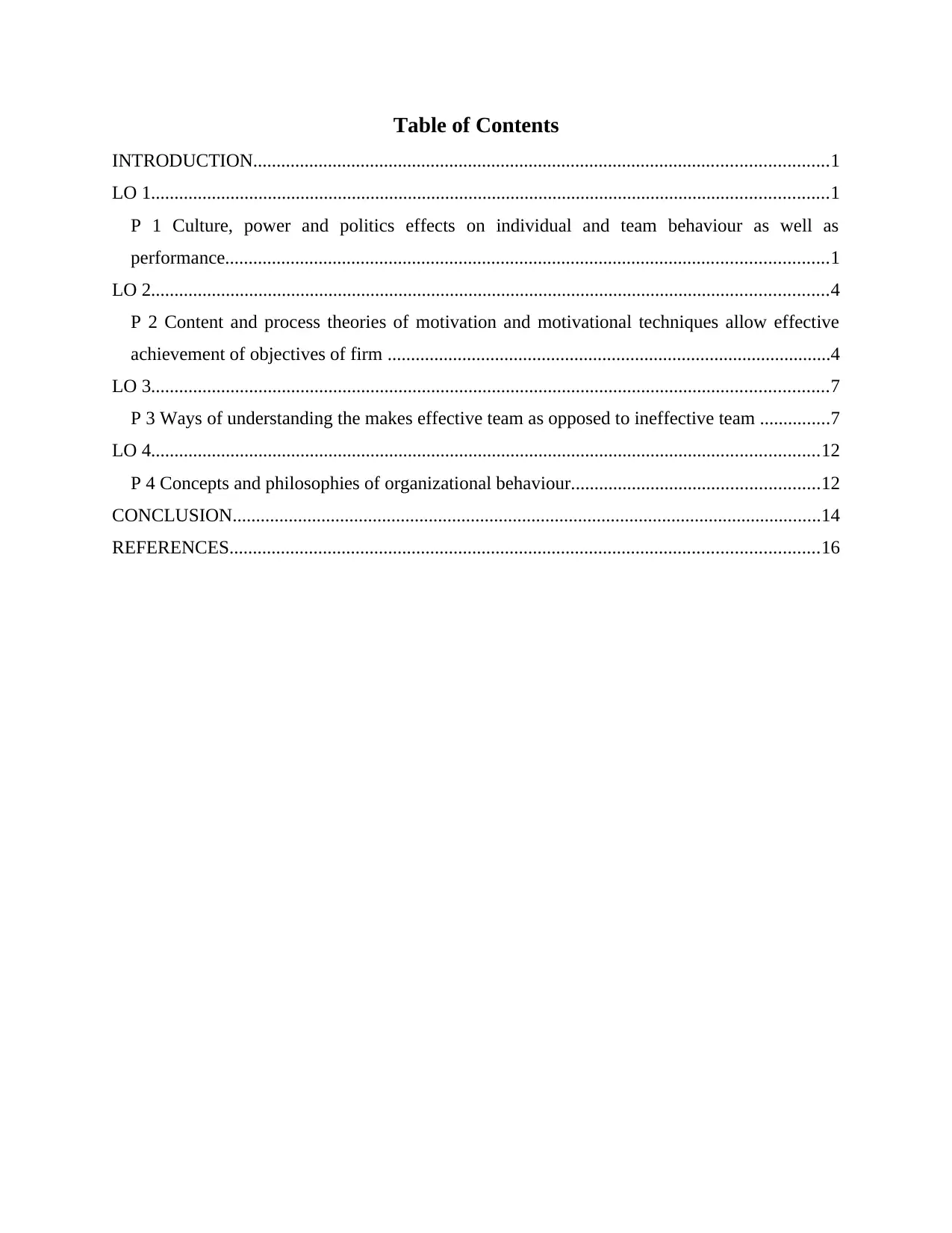
Table of Contents
INTRODUCTION...........................................................................................................................1
LO 1.................................................................................................................................................1
P 1 Culture, power and politics effects on individual and team behaviour as well as
performance.................................................................................................................................1
LO 2.................................................................................................................................................4
P 2 Content and process theories of motivation and motivational techniques allow effective
achievement of objectives of firm ...............................................................................................4
LO 3.................................................................................................................................................7
P 3 Ways of understanding the makes effective team as opposed to ineffective team ...............7
LO 4...............................................................................................................................................12
P 4 Concepts and philosophies of organizational behaviour.....................................................12
CONCLUSION..............................................................................................................................14
REFERENCES..............................................................................................................................16
INTRODUCTION...........................................................................................................................1
LO 1.................................................................................................................................................1
P 1 Culture, power and politics effects on individual and team behaviour as well as
performance.................................................................................................................................1
LO 2.................................................................................................................................................4
P 2 Content and process theories of motivation and motivational techniques allow effective
achievement of objectives of firm ...............................................................................................4
LO 3.................................................................................................................................................7
P 3 Ways of understanding the makes effective team as opposed to ineffective team ...............7
LO 4...............................................................................................................................................12
P 4 Concepts and philosophies of organizational behaviour.....................................................12
CONCLUSION..............................................................................................................................14
REFERENCES..............................................................................................................................16
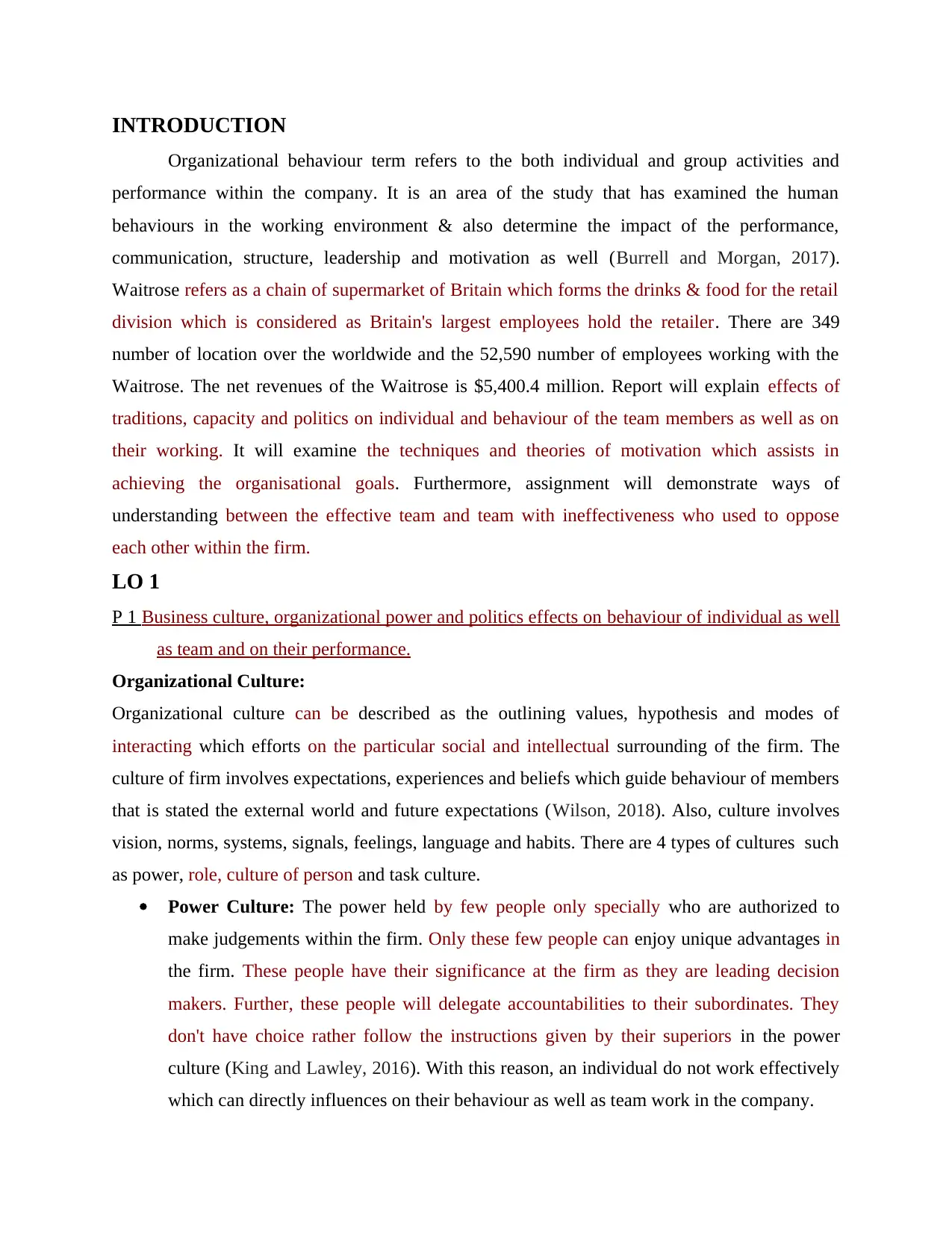
INTRODUCTION
Organizational behaviour term refers to the both individual and group activities and
performance within the company. It is an area of the study that has examined the human
behaviours in the working environment & also determine the impact of the performance,
communication, structure, leadership and motivation as well (Burrell and Morgan, 2017).
Waitrose refers as a chain of supermarket of Britain which forms the drinks & food for the retail
division which is considered as Britain's largest employees hold the retailer. There are 349
number of location over the worldwide and the 52,590 number of employees working with the
Waitrose. The net revenues of the Waitrose is $5,400.4 million. Report will explain effects of
traditions, capacity and politics on individual and behaviour of the team members as well as on
their working. It will examine the techniques and theories of motivation which assists in
achieving the organisational goals. Furthermore, assignment will demonstrate ways of
understanding between the effective team and team with ineffectiveness who used to oppose
each other within the firm.
LO 1
P 1 Business culture, organizational power and politics effects on behaviour of individual as well
as team and on their performance.
Organizational Culture:
Organizational culture can be described as the outlining values, hypothesis and modes of
interacting which efforts on the particular social and intellectual surrounding of the firm. The
culture of firm involves expectations, experiences and beliefs which guide behaviour of members
that is stated the external world and future expectations (Wilson, 2018). Also, culture involves
vision, norms, systems, signals, feelings, language and habits. There are 4 types of cultures such
as power, role, culture of person and task culture.
Power Culture: The power held by few people only specially who are authorized to
make judgements within the firm. Only these few people can enjoy unique advantages in
the firm. These people have their significance at the firm as they are leading decision
makers. Further, these people will delegate accountabilities to their subordinates. They
don't have choice rather follow the instructions given by their superiors in the power
culture (King and Lawley, 2016). With this reason, an individual do not work effectively
which can directly influences on their behaviour as well as team work in the company.
Organizational behaviour term refers to the both individual and group activities and
performance within the company. It is an area of the study that has examined the human
behaviours in the working environment & also determine the impact of the performance,
communication, structure, leadership and motivation as well (Burrell and Morgan, 2017).
Waitrose refers as a chain of supermarket of Britain which forms the drinks & food for the retail
division which is considered as Britain's largest employees hold the retailer. There are 349
number of location over the worldwide and the 52,590 number of employees working with the
Waitrose. The net revenues of the Waitrose is $5,400.4 million. Report will explain effects of
traditions, capacity and politics on individual and behaviour of the team members as well as on
their working. It will examine the techniques and theories of motivation which assists in
achieving the organisational goals. Furthermore, assignment will demonstrate ways of
understanding between the effective team and team with ineffectiveness who used to oppose
each other within the firm.
LO 1
P 1 Business culture, organizational power and politics effects on behaviour of individual as well
as team and on their performance.
Organizational Culture:
Organizational culture can be described as the outlining values, hypothesis and modes of
interacting which efforts on the particular social and intellectual surrounding of the firm. The
culture of firm involves expectations, experiences and beliefs which guide behaviour of members
that is stated the external world and future expectations (Wilson, 2018). Also, culture involves
vision, norms, systems, signals, feelings, language and habits. There are 4 types of cultures such
as power, role, culture of person and task culture.
Power Culture: The power held by few people only specially who are authorized to
make judgements within the firm. Only these few people can enjoy unique advantages in
the firm. These people have their significance at the firm as they are leading decision
makers. Further, these people will delegate accountabilities to their subordinates. They
don't have choice rather follow the instructions given by their superiors in the power
culture (King and Lawley, 2016). With this reason, an individual do not work effectively
which can directly influences on their behaviour as well as team work in the company.
⊘ This is a preview!⊘
Do you want full access?
Subscribe today to unlock all pages.

Trusted by 1+ million students worldwide
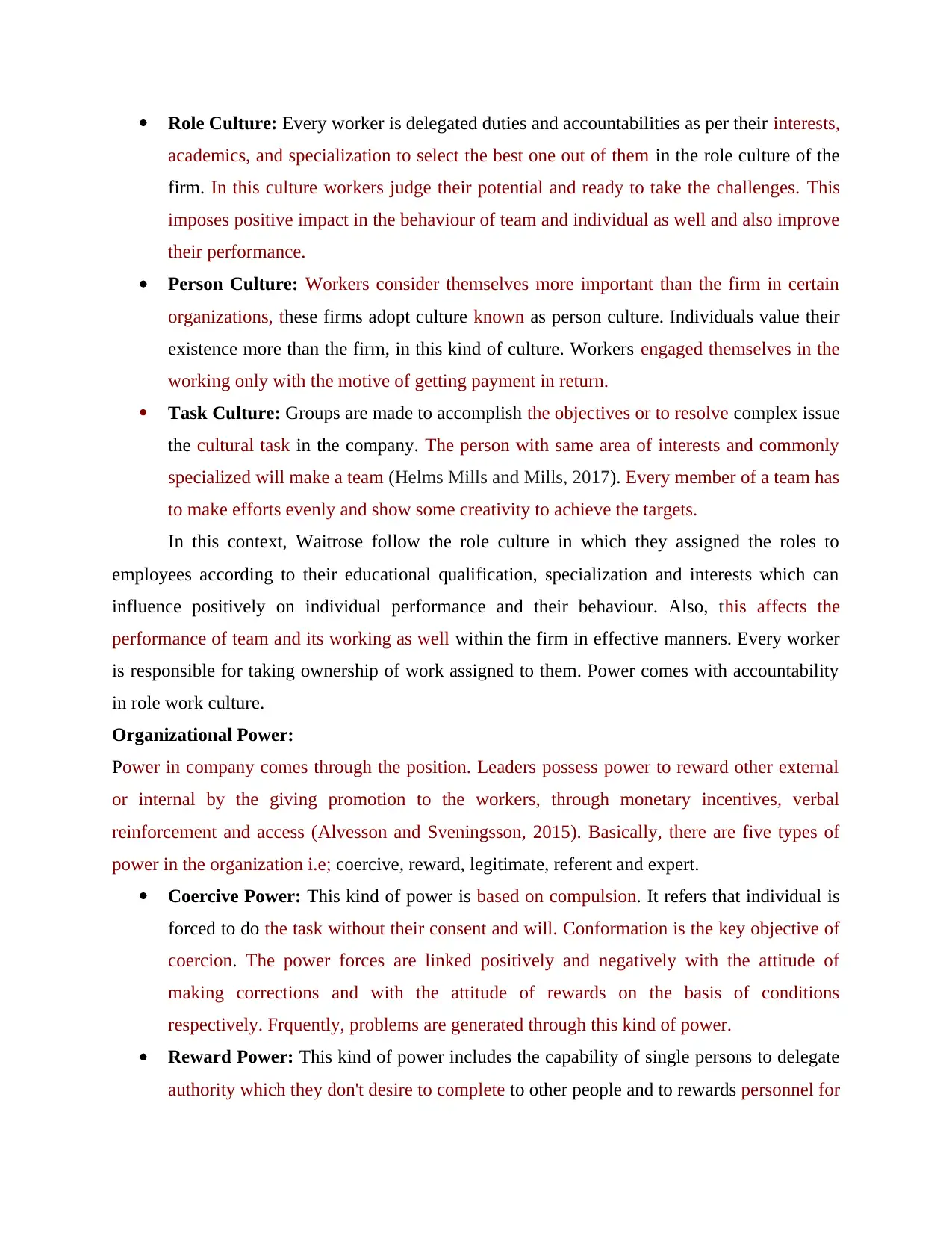
Role Culture: Every worker is delegated duties and accountabilities as per their interests,
academics, and specialization to select the best one out of them in the role culture of the
firm. In this culture workers judge their potential and ready to take the challenges. This
imposes positive impact in the behaviour of team and individual as well and also improve
their performance.
Person Culture: Workers consider themselves more important than the firm in certain
organizations, these firms adopt culture known as person culture. Individuals value their
existence more than the firm, in this kind of culture. Workers engaged themselves in the
working only with the motive of getting payment in return.
Task Culture: Groups are made to accomplish the objectives or to resolve complex issue
the cultural task in the company. The person with same area of interests and commonly
specialized will make a team (Helms Mills and Mills, 2017). Every member of a team has
to make efforts evenly and show some creativity to achieve the targets.
In this context, Waitrose follow the role culture in which they assigned the roles to
employees according to their educational qualification, specialization and interests which can
influence positively on individual performance and their behaviour. Also, this affects the
performance of team and its working as well within the firm in effective manners. Every worker
is responsible for taking ownership of work assigned to them. Power comes with accountability
in role work culture.
Organizational Power:
Power in company comes through the position. Leaders possess power to reward other external
or internal by the giving promotion to the workers, through monetary incentives, verbal
reinforcement and access (Alvesson and Sveningsson, 2015). Basically, there are five types of
power in the organization i.e; coercive, reward, legitimate, referent and expert.
Coercive Power: This kind of power is based on compulsion. It refers that individual is
forced to do the task without their consent and will. Conformation is the key objective of
coercion. The power forces are linked positively and negatively with the attitude of
making corrections and with the attitude of rewards on the basis of conditions
respectively. Frquently, problems are generated through this kind of power.
Reward Power: This kind of power includes the capability of single persons to delegate
authority which they don't desire to complete to other people and to rewards personnel for
academics, and specialization to select the best one out of them in the role culture of the
firm. In this culture workers judge their potential and ready to take the challenges. This
imposes positive impact in the behaviour of team and individual as well and also improve
their performance.
Person Culture: Workers consider themselves more important than the firm in certain
organizations, these firms adopt culture known as person culture. Individuals value their
existence more than the firm, in this kind of culture. Workers engaged themselves in the
working only with the motive of getting payment in return.
Task Culture: Groups are made to accomplish the objectives or to resolve complex issue
the cultural task in the company. The person with same area of interests and commonly
specialized will make a team (Helms Mills and Mills, 2017). Every member of a team has
to make efforts evenly and show some creativity to achieve the targets.
In this context, Waitrose follow the role culture in which they assigned the roles to
employees according to their educational qualification, specialization and interests which can
influence positively on individual performance and their behaviour. Also, this affects the
performance of team and its working as well within the firm in effective manners. Every worker
is responsible for taking ownership of work assigned to them. Power comes with accountability
in role work culture.
Organizational Power:
Power in company comes through the position. Leaders possess power to reward other external
or internal by the giving promotion to the workers, through monetary incentives, verbal
reinforcement and access (Alvesson and Sveningsson, 2015). Basically, there are five types of
power in the organization i.e; coercive, reward, legitimate, referent and expert.
Coercive Power: This kind of power is based on compulsion. It refers that individual is
forced to do the task without their consent and will. Conformation is the key objective of
coercion. The power forces are linked positively and negatively with the attitude of
making corrections and with the attitude of rewards on the basis of conditions
respectively. Frquently, problems are generated through this kind of power.
Reward Power: This kind of power includes the capability of single persons to delegate
authority which they don't desire to complete to other people and to rewards personnel for
Paraphrase This Document
Need a fresh take? Get an instant paraphrase of this document with our AI Paraphraser
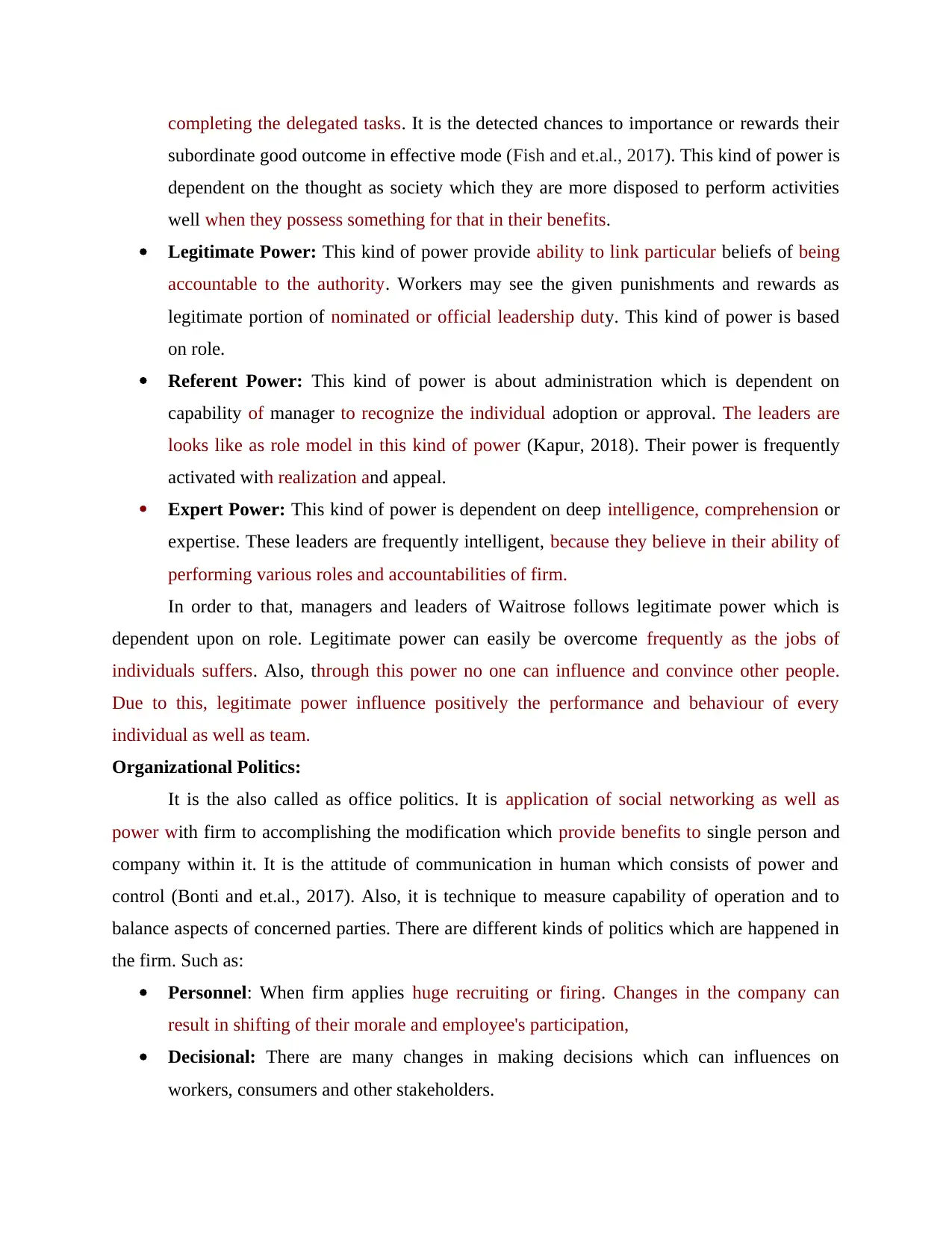
completing the delegated tasks. It is the detected chances to importance or rewards their
subordinate good outcome in effective mode (Fish and et.al., 2017). This kind of power is
dependent on the thought as society which they are more disposed to perform activities
well when they possess something for that in their benefits.
Legitimate Power: This kind of power provide ability to link particular beliefs of being
accountable to the authority. Workers may see the given punishments and rewards as
legitimate portion of nominated or official leadership duty. This kind of power is based
on role.
Referent Power: This kind of power is about administration which is dependent on
capability of manager to recognize the individual adoption or approval. The leaders are
looks like as role model in this kind of power (Kapur, 2018). Their power is frequently
activated with realization and appeal.
Expert Power: This kind of power is dependent on deep intelligence, comprehension or
expertise. These leaders are frequently intelligent, because they believe in their ability of
performing various roles and accountabilities of firm.
In order to that, managers and leaders of Waitrose follows legitimate power which is
dependent upon on role. Legitimate power can easily be overcome frequently as the jobs of
individuals suffers. Also, through this power no one can influence and convince other people.
Due to this, legitimate power influence positively the performance and behaviour of every
individual as well as team.
Organizational Politics:
It is the also called as office politics. It is application of social networking as well as
power with firm to accomplishing the modification which provide benefits to single person and
company within it. It is the attitude of communication in human which consists of power and
control (Bonti and et.al., 2017). Also, it is technique to measure capability of operation and to
balance aspects of concerned parties. There are different kinds of politics which are happened in
the firm. Such as:
Personnel: When firm applies huge recruiting or firing. Changes in the company can
result in shifting of their morale and employee's participation,
Decisional: There are many changes in making decisions which can influences on
workers, consumers and other stakeholders.
subordinate good outcome in effective mode (Fish and et.al., 2017). This kind of power is
dependent on the thought as society which they are more disposed to perform activities
well when they possess something for that in their benefits.
Legitimate Power: This kind of power provide ability to link particular beliefs of being
accountable to the authority. Workers may see the given punishments and rewards as
legitimate portion of nominated or official leadership duty. This kind of power is based
on role.
Referent Power: This kind of power is about administration which is dependent on
capability of manager to recognize the individual adoption or approval. The leaders are
looks like as role model in this kind of power (Kapur, 2018). Their power is frequently
activated with realization and appeal.
Expert Power: This kind of power is dependent on deep intelligence, comprehension or
expertise. These leaders are frequently intelligent, because they believe in their ability of
performing various roles and accountabilities of firm.
In order to that, managers and leaders of Waitrose follows legitimate power which is
dependent upon on role. Legitimate power can easily be overcome frequently as the jobs of
individuals suffers. Also, through this power no one can influence and convince other people.
Due to this, legitimate power influence positively the performance and behaviour of every
individual as well as team.
Organizational Politics:
It is the also called as office politics. It is application of social networking as well as
power with firm to accomplishing the modification which provide benefits to single person and
company within it. It is the attitude of communication in human which consists of power and
control (Bonti and et.al., 2017). Also, it is technique to measure capability of operation and to
balance aspects of concerned parties. There are different kinds of politics which are happened in
the firm. Such as:
Personnel: When firm applies huge recruiting or firing. Changes in the company can
result in shifting of their morale and employee's participation,
Decisional: There are many changes in making decisions which can influences on
workers, consumers and other stakeholders.

Structural: These kinds of changes are happened to structure of firm which can variety
form inside or outside factors that influence on ways via company is run. These
modifications includes creating modification to overall objectives, strategy or mission of
firm (Menard, Bott and Crossler, 2017).
Organizational: It refers as a large scale modification which impacts on the performance
of an individual along with entire firm. This can involve renovating of leadership,
introducing new policies or launching the new business technology.
In order to that, managers and leaders of Waitrose adopt the structural changes which can
influence on the performance and behaviour of individual, because it is difficult to adopt the
alteration in structure and also do not work effectively. This can directly influence on the
performance of the team and its work within the firm.
LO 2
P 2 Content and process theories of motivation and motivational techniques allow effective
achievement of objectives of firm
Content theory of Motivation:
The content theory attend to be earlier approaches of motivation. This theory can called as needs
theory, because they are normally linked with aspect which focus on significance of defining
motives them (Lăzăroiu, 2015). In another term, they seek to determine needs of employees and
also relate to motivation to the fulfilling of these wants. There are various content theories of
motivation such as:
Maslow's Hierarchy of Needs:
Maslow put forward the thought which there survive the hierarchy of needs consisting of
five levels which developed from lower order wants through to the largest level needs. The
physiological, social and social needs are called as deficiency needs. Also, esteem and self-
actualization needs are known as growth needs.
Physiological Needs: It involves the most basic needs for human to live like air, water
and food. These needs are the most dominants of the requirements.
Safety Needs: It involves salary, security of income, employment, good health, financial
security, illness and so on (Woodcock, 2017).
form inside or outside factors that influence on ways via company is run. These
modifications includes creating modification to overall objectives, strategy or mission of
firm (Menard, Bott and Crossler, 2017).
Organizational: It refers as a large scale modification which impacts on the performance
of an individual along with entire firm. This can involve renovating of leadership,
introducing new policies or launching the new business technology.
In order to that, managers and leaders of Waitrose adopt the structural changes which can
influence on the performance and behaviour of individual, because it is difficult to adopt the
alteration in structure and also do not work effectively. This can directly influence on the
performance of the team and its work within the firm.
LO 2
P 2 Content and process theories of motivation and motivational techniques allow effective
achievement of objectives of firm
Content theory of Motivation:
The content theory attend to be earlier approaches of motivation. This theory can called as needs
theory, because they are normally linked with aspect which focus on significance of defining
motives them (Lăzăroiu, 2015). In another term, they seek to determine needs of employees and
also relate to motivation to the fulfilling of these wants. There are various content theories of
motivation such as:
Maslow's Hierarchy of Needs:
Maslow put forward the thought which there survive the hierarchy of needs consisting of
five levels which developed from lower order wants through to the largest level needs. The
physiological, social and social needs are called as deficiency needs. Also, esteem and self-
actualization needs are known as growth needs.
Physiological Needs: It involves the most basic needs for human to live like air, water
and food. These needs are the most dominants of the requirements.
Safety Needs: It involves salary, security of income, employment, good health, financial
security, illness and so on (Woodcock, 2017).
⊘ This is a preview!⊘
Do you want full access?
Subscribe today to unlock all pages.

Trusted by 1+ million students worldwide
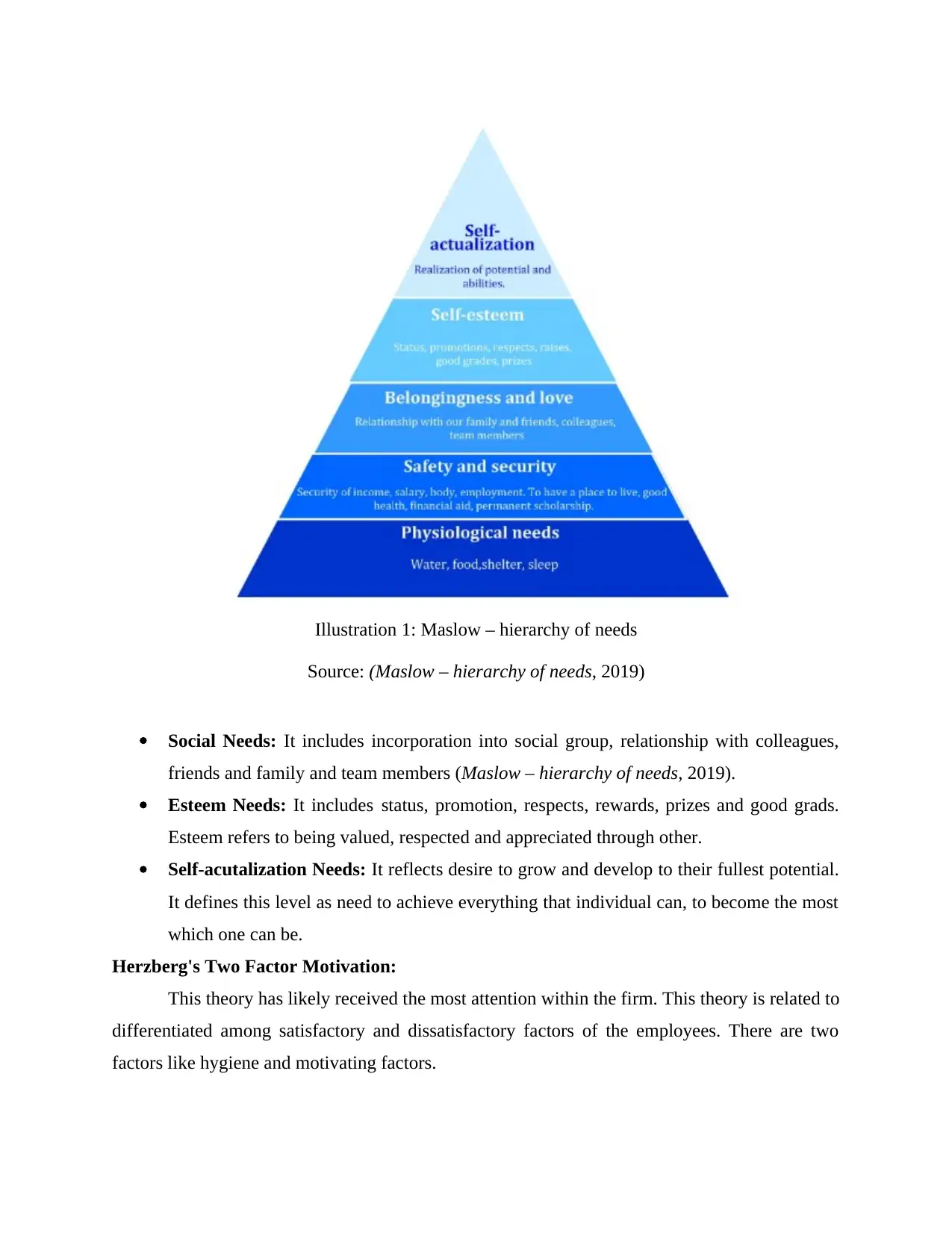
Social Needs: It includes incorporation into social group, relationship with colleagues,
friends and family and team members (Maslow – hierarchy of needs, 2019).
Esteem Needs: It includes status, promotion, respects, rewards, prizes and good grads.
Esteem refers to being valued, respected and appreciated through other.
Self-acutalization Needs: It reflects desire to grow and develop to their fullest potential.
It defines this level as need to achieve everything that individual can, to become the most
which one can be.
Herzberg's Two Factor Motivation:
This theory has likely received the most attention within the firm. This theory is related to
differentiated among satisfactory and dissatisfactory factors of the employees. There are two
factors like hygiene and motivating factors.
Illustration 1: Maslow – hierarchy of needs
Source: (Maslow – hierarchy of needs, 2019)
friends and family and team members (Maslow – hierarchy of needs, 2019).
Esteem Needs: It includes status, promotion, respects, rewards, prizes and good grads.
Esteem refers to being valued, respected and appreciated through other.
Self-acutalization Needs: It reflects desire to grow and develop to their fullest potential.
It defines this level as need to achieve everything that individual can, to become the most
which one can be.
Herzberg's Two Factor Motivation:
This theory has likely received the most attention within the firm. This theory is related to
differentiated among satisfactory and dissatisfactory factors of the employees. There are two
factors like hygiene and motivating factors.
Illustration 1: Maslow – hierarchy of needs
Source: (Maslow – hierarchy of needs, 2019)
Paraphrase This Document
Need a fresh take? Get an instant paraphrase of this document with our AI Paraphraser
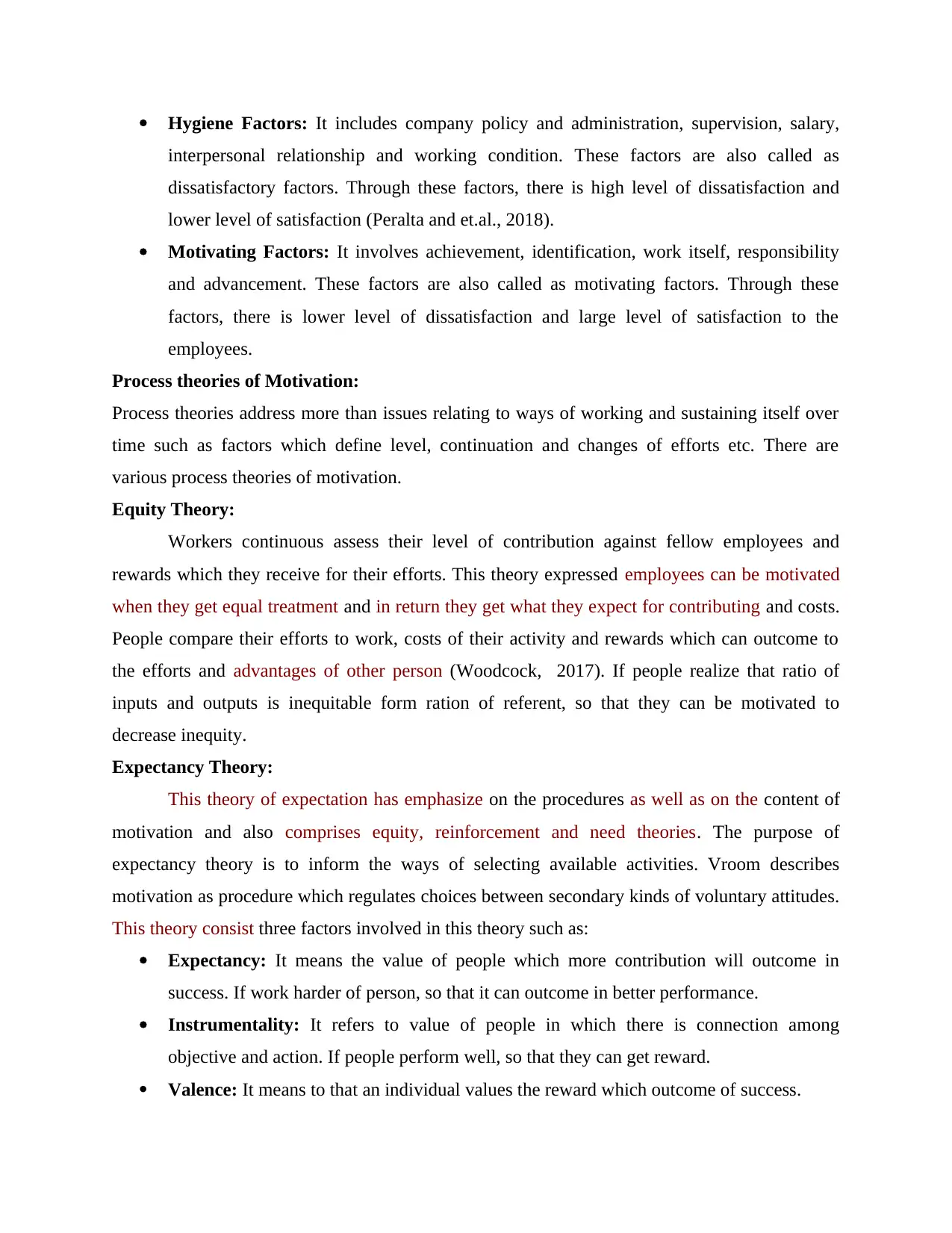
Hygiene Factors: It includes company policy and administration, supervision, salary,
interpersonal relationship and working condition. These factors are also called as
dissatisfactory factors. Through these factors, there is high level of dissatisfaction and
lower level of satisfaction (Peralta and et.al., 2018).
Motivating Factors: It involves achievement, identification, work itself, responsibility
and advancement. These factors are also called as motivating factors. Through these
factors, there is lower level of dissatisfaction and large level of satisfaction to the
employees.
Process theories of Motivation:
Process theories address more than issues relating to ways of working and sustaining itself over
time such as factors which define level, continuation and changes of efforts etc. There are
various process theories of motivation.
Equity Theory:
Workers continuous assess their level of contribution against fellow employees and
rewards which they receive for their efforts. This theory expressed employees can be motivated
when they get equal treatment and in return they get what they expect for contributing and costs.
People compare their efforts to work, costs of their activity and rewards which can outcome to
the efforts and advantages of other person (Woodcock, 2017). If people realize that ratio of
inputs and outputs is inequitable form ration of referent, so that they can be motivated to
decrease inequity.
Expectancy Theory:
This theory of expectation has emphasize on the procedures as well as on the content of
motivation and also comprises equity, reinforcement and need theories. The purpose of
expectancy theory is to inform the ways of selecting available activities. Vroom describes
motivation as procedure which regulates choices between secondary kinds of voluntary attitudes.
This theory consist three factors involved in this theory such as:
Expectancy: It means the value of people which more contribution will outcome in
success. If work harder of person, so that it can outcome in better performance.
Instrumentality: It refers to value of people in which there is connection among
objective and action. If people perform well, so that they can get reward.
Valence: It means to that an individual values the reward which outcome of success.
interpersonal relationship and working condition. These factors are also called as
dissatisfactory factors. Through these factors, there is high level of dissatisfaction and
lower level of satisfaction (Peralta and et.al., 2018).
Motivating Factors: It involves achievement, identification, work itself, responsibility
and advancement. These factors are also called as motivating factors. Through these
factors, there is lower level of dissatisfaction and large level of satisfaction to the
employees.
Process theories of Motivation:
Process theories address more than issues relating to ways of working and sustaining itself over
time such as factors which define level, continuation and changes of efforts etc. There are
various process theories of motivation.
Equity Theory:
Workers continuous assess their level of contribution against fellow employees and
rewards which they receive for their efforts. This theory expressed employees can be motivated
when they get equal treatment and in return they get what they expect for contributing and costs.
People compare their efforts to work, costs of their activity and rewards which can outcome to
the efforts and advantages of other person (Woodcock, 2017). If people realize that ratio of
inputs and outputs is inequitable form ration of referent, so that they can be motivated to
decrease inequity.
Expectancy Theory:
This theory of expectation has emphasize on the procedures as well as on the content of
motivation and also comprises equity, reinforcement and need theories. The purpose of
expectancy theory is to inform the ways of selecting available activities. Vroom describes
motivation as procedure which regulates choices between secondary kinds of voluntary attitudes.
This theory consist three factors involved in this theory such as:
Expectancy: It means the value of people which more contribution will outcome in
success. If work harder of person, so that it can outcome in better performance.
Instrumentality: It refers to value of people in which there is connection among
objective and action. If people perform well, so that they can get reward.
Valence: It means to that an individual values the reward which outcome of success.
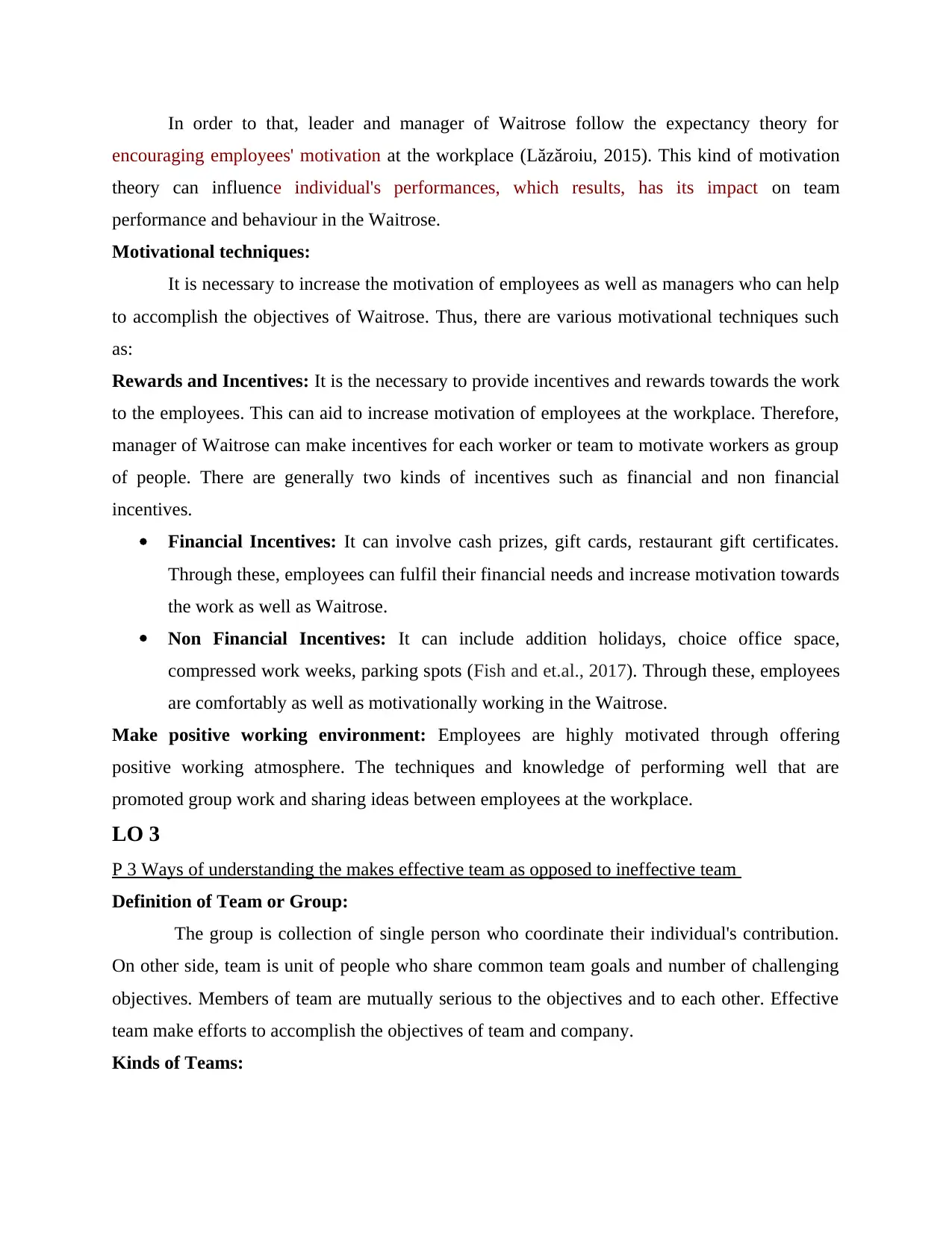
In order to that, leader and manager of Waitrose follow the expectancy theory for
encouraging employees' motivation at the workplace (Lăzăroiu, 2015). This kind of motivation
theory can influence individual's performances, which results, has its impact on team
performance and behaviour in the Waitrose.
Motivational techniques:
It is necessary to increase the motivation of employees as well as managers who can help
to accomplish the objectives of Waitrose. Thus, there are various motivational techniques such
as:
Rewards and Incentives: It is the necessary to provide incentives and rewards towards the work
to the employees. This can aid to increase motivation of employees at the workplace. Therefore,
manager of Waitrose can make incentives for each worker or team to motivate workers as group
of people. There are generally two kinds of incentives such as financial and non financial
incentives.
Financial Incentives: It can involve cash prizes, gift cards, restaurant gift certificates.
Through these, employees can fulfil their financial needs and increase motivation towards
the work as well as Waitrose.
Non Financial Incentives: It can include addition holidays, choice office space,
compressed work weeks, parking spots (Fish and et.al., 2017). Through these, employees
are comfortably as well as motivationally working in the Waitrose.
Make positive working environment: Employees are highly motivated through offering
positive working atmosphere. The techniques and knowledge of performing well that are
promoted group work and sharing ideas between employees at the workplace.
LO 3
P 3 Ways of understanding the makes effective team as opposed to ineffective team
Definition of Team or Group:
The group is collection of single person who coordinate their individual's contribution.
On other side, team is unit of people who share common team goals and number of challenging
objectives. Members of team are mutually serious to the objectives and to each other. Effective
team make efforts to accomplish the objectives of team and company.
Kinds of Teams:
encouraging employees' motivation at the workplace (Lăzăroiu, 2015). This kind of motivation
theory can influence individual's performances, which results, has its impact on team
performance and behaviour in the Waitrose.
Motivational techniques:
It is necessary to increase the motivation of employees as well as managers who can help
to accomplish the objectives of Waitrose. Thus, there are various motivational techniques such
as:
Rewards and Incentives: It is the necessary to provide incentives and rewards towards the work
to the employees. This can aid to increase motivation of employees at the workplace. Therefore,
manager of Waitrose can make incentives for each worker or team to motivate workers as group
of people. There are generally two kinds of incentives such as financial and non financial
incentives.
Financial Incentives: It can involve cash prizes, gift cards, restaurant gift certificates.
Through these, employees can fulfil their financial needs and increase motivation towards
the work as well as Waitrose.
Non Financial Incentives: It can include addition holidays, choice office space,
compressed work weeks, parking spots (Fish and et.al., 2017). Through these, employees
are comfortably as well as motivationally working in the Waitrose.
Make positive working environment: Employees are highly motivated through offering
positive working atmosphere. The techniques and knowledge of performing well that are
promoted group work and sharing ideas between employees at the workplace.
LO 3
P 3 Ways of understanding the makes effective team as opposed to ineffective team
Definition of Team or Group:
The group is collection of single person who coordinate their individual's contribution.
On other side, team is unit of people who share common team goals and number of challenging
objectives. Members of team are mutually serious to the objectives and to each other. Effective
team make efforts to accomplish the objectives of team and company.
Kinds of Teams:
⊘ This is a preview!⊘
Do you want full access?
Subscribe today to unlock all pages.

Trusted by 1+ million students worldwide
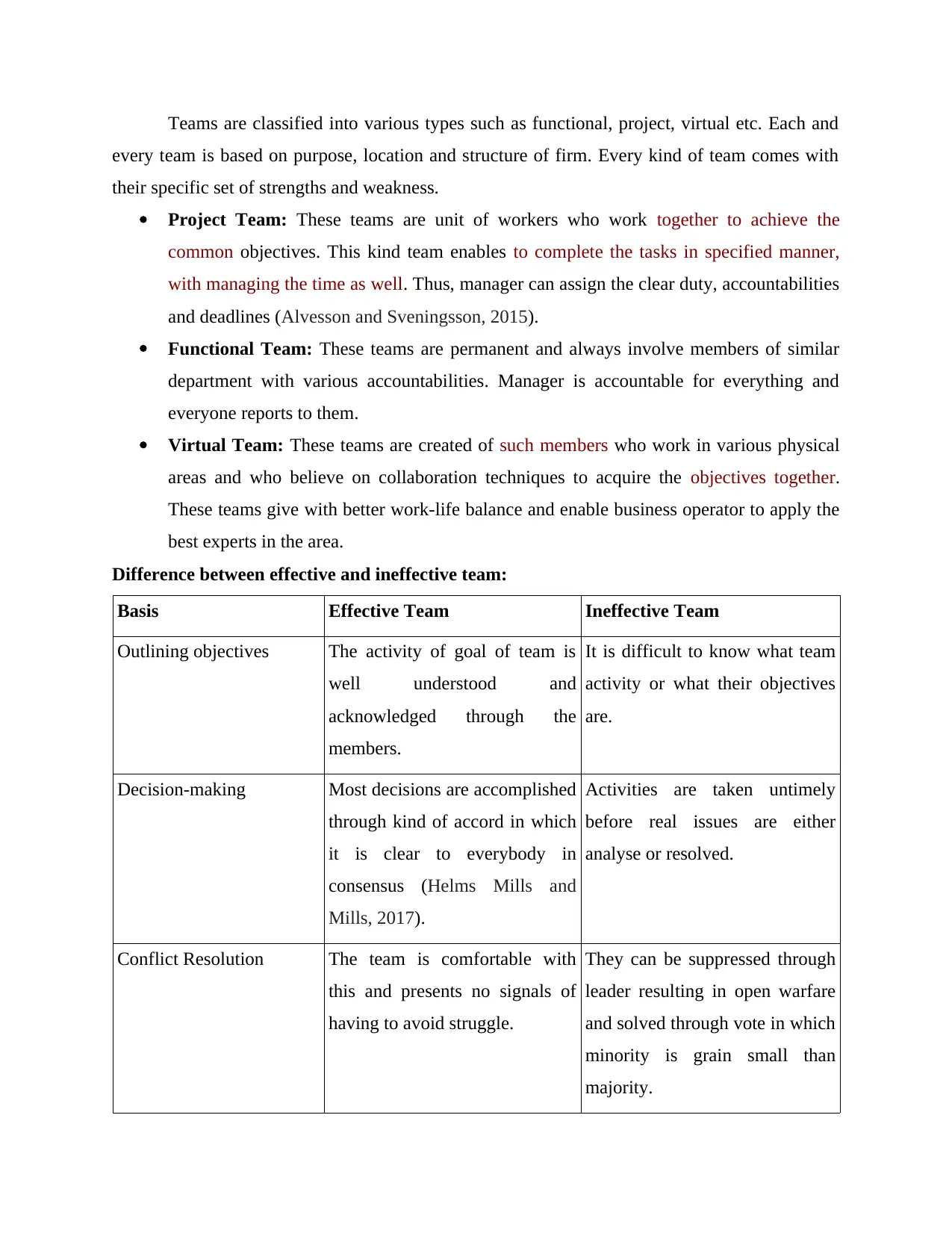
Teams are classified into various types such as functional, project, virtual etc. Each and
every team is based on purpose, location and structure of firm. Every kind of team comes with
their specific set of strengths and weakness.
Project Team: These teams are unit of workers who work together to achieve the
common objectives. This kind team enables to complete the tasks in specified manner,
with managing the time as well. Thus, manager can assign the clear duty, accountabilities
and deadlines (Alvesson and Sveningsson, 2015).
Functional Team: These teams are permanent and always involve members of similar
department with various accountabilities. Manager is accountable for everything and
everyone reports to them.
Virtual Team: These teams are created of such members who work in various physical
areas and who believe on collaboration techniques to acquire the objectives together.
These teams give with better work-life balance and enable business operator to apply the
best experts in the area.
Difference between effective and ineffective team:
Basis Effective Team Ineffective Team
Outlining objectives The activity of goal of team is
well understood and
acknowledged through the
members.
It is difficult to know what team
activity or what their objectives
are.
Decision-making Most decisions are accomplished
through kind of accord in which
it is clear to everybody in
consensus (Helms Mills and
Mills, 2017).
Activities are taken untimely
before real issues are either
analyse or resolved.
Conflict Resolution The team is comfortable with
this and presents no signals of
having to avoid struggle.
They can be suppressed through
leader resulting in open warfare
and solved through vote in which
minority is grain small than
majority.
every team is based on purpose, location and structure of firm. Every kind of team comes with
their specific set of strengths and weakness.
Project Team: These teams are unit of workers who work together to achieve the
common objectives. This kind team enables to complete the tasks in specified manner,
with managing the time as well. Thus, manager can assign the clear duty, accountabilities
and deadlines (Alvesson and Sveningsson, 2015).
Functional Team: These teams are permanent and always involve members of similar
department with various accountabilities. Manager is accountable for everything and
everyone reports to them.
Virtual Team: These teams are created of such members who work in various physical
areas and who believe on collaboration techniques to acquire the objectives together.
These teams give with better work-life balance and enable business operator to apply the
best experts in the area.
Difference between effective and ineffective team:
Basis Effective Team Ineffective Team
Outlining objectives The activity of goal of team is
well understood and
acknowledged through the
members.
It is difficult to know what team
activity or what their objectives
are.
Decision-making Most decisions are accomplished
through kind of accord in which
it is clear to everybody in
consensus (Helms Mills and
Mills, 2017).
Activities are taken untimely
before real issues are either
analyse or resolved.
Conflict Resolution The team is comfortable with
this and presents no signals of
having to avoid struggle.
They can be suppressed through
leader resulting in open warfare
and solved through vote in which
minority is grain small than
majority.
Paraphrase This Document
Need a fresh take? Get an instant paraphrase of this document with our AI Paraphraser
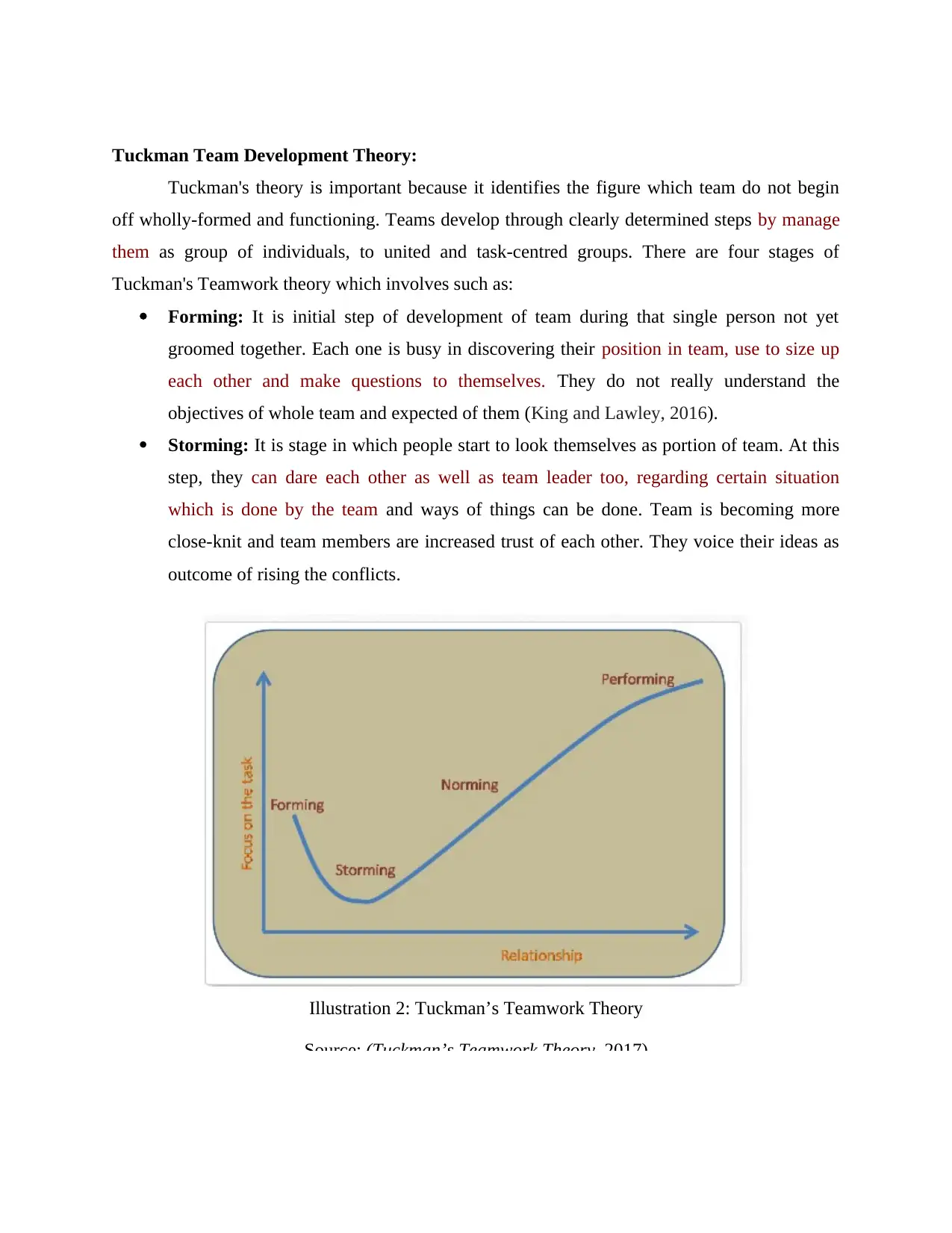
Tuckman Team Development Theory:
Tuckman's theory is important because it identifies the figure which team do not begin
off wholly-formed and functioning. Teams develop through clearly determined steps by manage
them as group of individuals, to united and task-centred groups. There are four stages of
Tuckman's Teamwork theory which involves such as:
Forming: It is initial step of development of team during that single person not yet
groomed together. Each one is busy in discovering their position in team, use to size up
each other and make questions to themselves. They do not really understand the
objectives of whole team and expected of them (King and Lawley, 2016).
Storming: It is stage in which people start to look themselves as portion of team. At this
step, they can dare each other as well as team leader too, regarding certain situation
which is done by the team and ways of things can be done. Team is becoming more
close-knit and team members are increased trust of each other. They voice their ideas as
outcome of rising the conflicts.
Illustration 2: Tuckman’s Teamwork Theory
Source: (Tuckman’s Teamwork Theory, 2017)
Tuckman's theory is important because it identifies the figure which team do not begin
off wholly-formed and functioning. Teams develop through clearly determined steps by manage
them as group of individuals, to united and task-centred groups. There are four stages of
Tuckman's Teamwork theory which involves such as:
Forming: It is initial step of development of team during that single person not yet
groomed together. Each one is busy in discovering their position in team, use to size up
each other and make questions to themselves. They do not really understand the
objectives of whole team and expected of them (King and Lawley, 2016).
Storming: It is stage in which people start to look themselves as portion of team. At this
step, they can dare each other as well as team leader too, regarding certain situation
which is done by the team and ways of things can be done. Team is becoming more
close-knit and team members are increased trust of each other. They voice their ideas as
outcome of rising the conflicts.
Illustration 2: Tuckman’s Teamwork Theory
Source: (Tuckman’s Teamwork Theory, 2017)
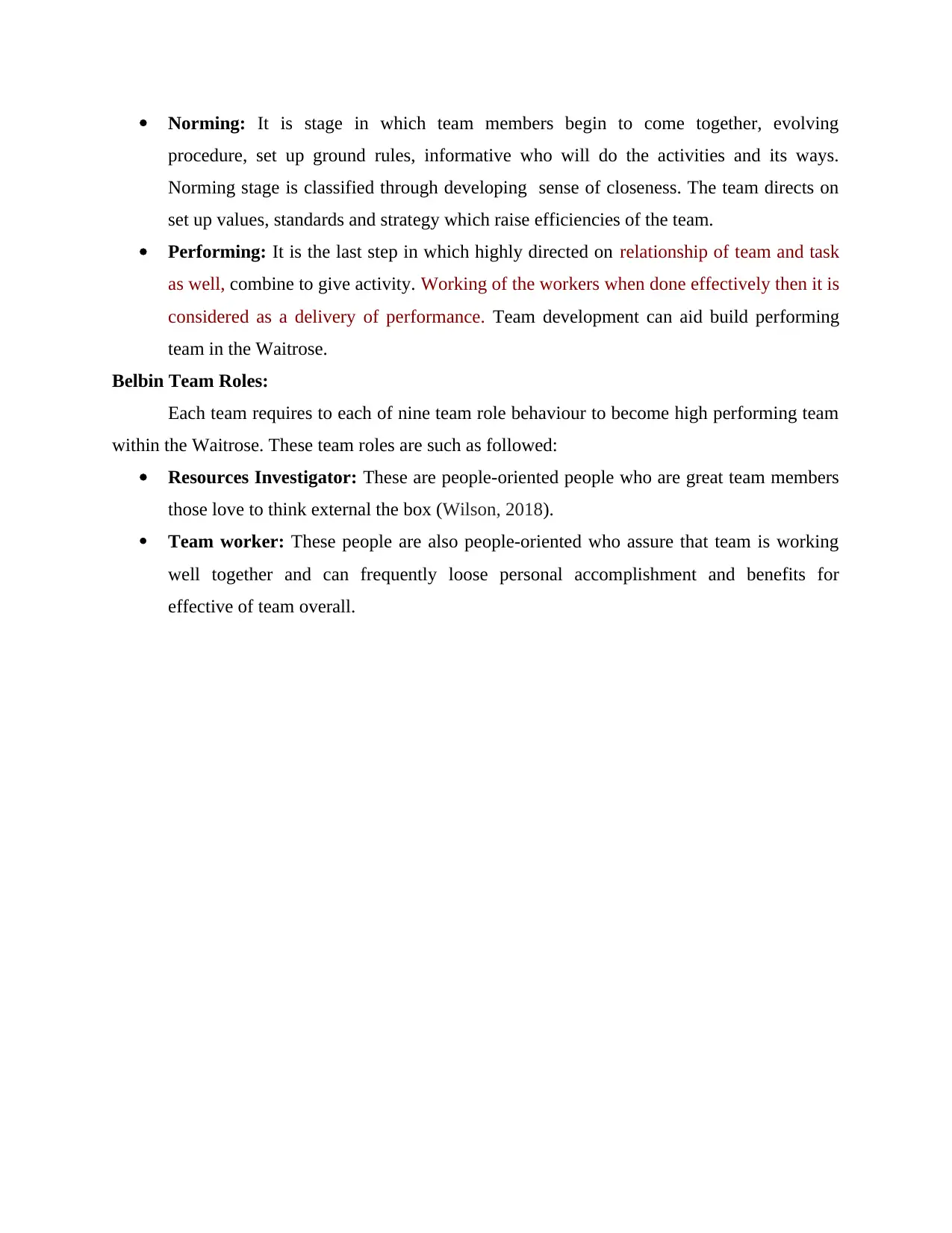
Norming: It is stage in which team members begin to come together, evolving
procedure, set up ground rules, informative who will do the activities and its ways.
Norming stage is classified through developing sense of closeness. The team directs on
set up values, standards and strategy which raise efficiencies of the team.
Performing: It is the last step in which highly directed on relationship of team and task
as well, combine to give activity. Working of the workers when done effectively then it is
considered as a delivery of performance. Team development can aid build performing
team in the Waitrose.
Belbin Team Roles:
Each team requires to each of nine team role behaviour to become high performing team
within the Waitrose. These team roles are such as followed:
Resources Investigator: These are people-oriented people who are great team members
those love to think external the box (Wilson, 2018).
Team worker: These people are also people-oriented who assure that team is working
well together and can frequently loose personal accomplishment and benefits for
effective of team overall.
procedure, set up ground rules, informative who will do the activities and its ways.
Norming stage is classified through developing sense of closeness. The team directs on
set up values, standards and strategy which raise efficiencies of the team.
Performing: It is the last step in which highly directed on relationship of team and task
as well, combine to give activity. Working of the workers when done effectively then it is
considered as a delivery of performance. Team development can aid build performing
team in the Waitrose.
Belbin Team Roles:
Each team requires to each of nine team role behaviour to become high performing team
within the Waitrose. These team roles are such as followed:
Resources Investigator: These are people-oriented people who are great team members
those love to think external the box (Wilson, 2018).
Team worker: These people are also people-oriented who assure that team is working
well together and can frequently loose personal accomplishment and benefits for
effective of team overall.
⊘ This is a preview!⊘
Do you want full access?
Subscribe today to unlock all pages.

Trusted by 1+ million students worldwide
1 out of 19
Related Documents
Your All-in-One AI-Powered Toolkit for Academic Success.
+13062052269
info@desklib.com
Available 24*7 on WhatsApp / Email
![[object Object]](/_next/static/media/star-bottom.7253800d.svg)
Unlock your academic potential
Copyright © 2020–2025 A2Z Services. All Rights Reserved. Developed and managed by ZUCOL.





